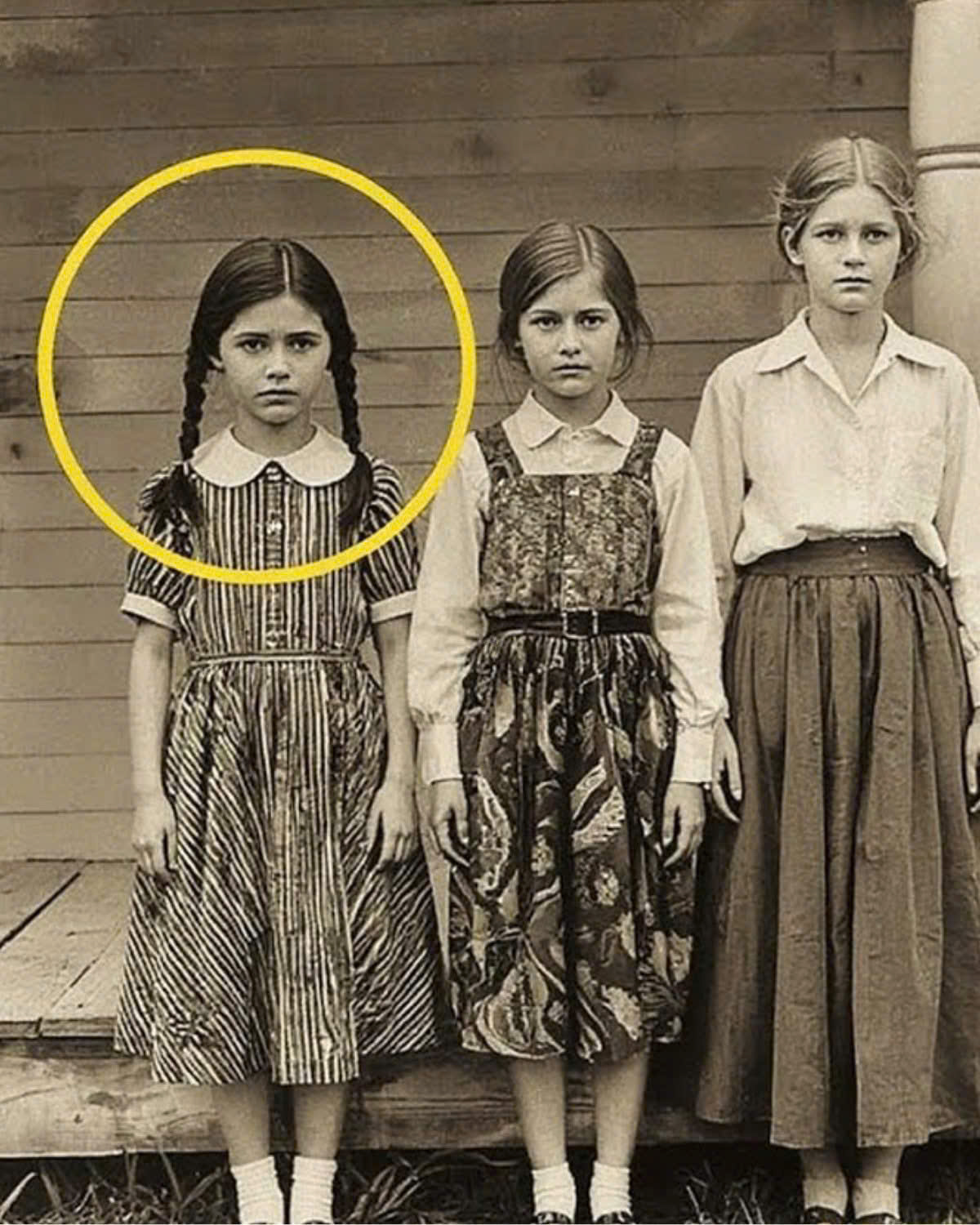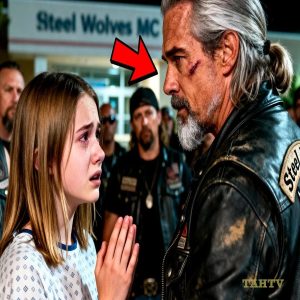Imagine three girls in 1912 posing outside a dusty textile mill. Just a frozen moment in time. But over 100 years later, when scientists zoom in on that very photograph, what they uncover doesn’t just rewrite history, it stuns the scientific world. Before we dive into this extraordinary discovery, make sure to like this video and subscribe to our channel for more real life stories that unravel the hidden layers of the past. A snapshot through time.
In the early 20th century, child labor was a grim norm across the American South. Factories buzzed with young workers, barely teenagers, spinning thread, fixing looms, breathing in fibers that silently poisoned them. Among them were Pearl Viola and Penelopey, three girls from Gastonia, North Carolina. On one routine afternoon in 1912, they were asked to step outside and pose for a photograph.
No one thought much of it, but that grainy image would live on, and a century later, it would reveal something that challenged everything scientists thought they knew about human biology, genetics, and industrial era survival. The photo that started it all. The man behind the camera was Thomas Himmel, a photographer documenting child labor for reform efforts.
The image showed three girls standing in front of the Port Mills accounting office. Pearl Turner, 9 years old, with dark eyes that looked far older than her age. Viola Turner, her 14-year-old sister, already weary from years of mill work. Penelopey, a 12-year-old neighbor, the mystery girl with no known family records. The girls were rigid, serious, their clothes simple, their faces lined not by time, but by labor.
After the flash, they turned and went back to work. But Pearl cast one last glance at the camera. Fast forward to the future. Over a century later, Professor Sonia Abernathy, a historical archavist, was working with her assistant Marcus to digitize the Thomas Himl photo collection. When Marcus brought her the image, he didn’t expect much until he did a little digging.
Pearl Turner, it turned out, didn’t die young like so many mill workers. She lived until 1964, well into her 60s. For someone who began dangerous mill work at 6 years old, this was shocking…………![]()
![]()
![]()

Imagine three girls in 1912 posing outside a dusty textile mill. Just a frozen moment in time. But over 100 years later, when scientists zoom in on that very photograph, what they uncover doesn’t just rewrite history, it stuns the scientific world. Before we dive into this extraordinary discovery, make sure to like this video and subscribe to our channel for more real life stories that unravel the hidden layers of the past. A snapshot through time.
In the early 20th century, child labor was a grim norm across the American South. Factories buzzed with young workers, barely teenagers, spinning thread, fixing looms, breathing in fibers that silently poisoned them. Among them were Pearl Viola and Penelopey, three girls from Gastonia, North Carolina. On one routine afternoon in 1912, they were asked to step outside and pose for a photograph.
No one thought much of it, but that grainy image would live on, and a century later, it would reveal something that challenged everything scientists thought they knew about human biology, genetics, and industrial era survival. The photo that started it all. The man behind the camera was Thomas Himmel, a photographer documenting child labor for reform efforts.
The image showed three girls standing in front of the Port Mills accounting office. Pearl Turner, 9 years old, with dark eyes that looked far older than her age. Viola Turner, her 14-year-old sister, already weary from years of mill work. Penelopey, a 12-year-old neighbor, the mystery girl with no known family records. The girls were rigid, serious, their clothes simple, their faces lined not by time, but by labor.
After the flash, they turned and went back to work. But Pearl cast one last glance at the camera. Fast forward to the future. Over a century later, Professor Sonia Abernathy, a historical archavist, was working with her assistant Marcus to digitize the Thomas Himl photo collection. When Marcus brought her the image, he didn’t expect much until he did a little digging.
Pearl Turner, it turned out, didn’t die young like so many mill workers. She lived until 1964, well into her 60s. For someone who began dangerous mill work at 6 years old, this was shocking. And then Marcus asked the question that changed everything. Can we enhance this image? Maybe use facial recognition just to see what else we might find.
Sonia, curious but skeptical, agreed. The enhancement. Using state-of-the-art image enhancement tech developed for art restoration, Marcus and Sonia magnified Pearl’s face in the photo far beyond what was previously possible. What they found shocked them. Subtle markers, barely perceptible skin differences, unusual nasal structure, and distinctive folds around the eyes suggested Pearl Turner had something different about her, a possible genetic anomaly.
They compared her features with medical journals, old case studies, and photographs from other mill workers. None matched what they saw in Pearl. And the more they searched, the more it looked like she had a rare mutation that protected her body from the dangers of cotton mill life. The medical implications begin.
As they dug into Pearl’s family history, they found a chilling contrast. Viola Pearl’s sister died just four years after the photograph from tuberculosis, worsened by mill exposure. Four of their other siblings died before the age of 20. But Pearl, not only did she live, she thrived by comparison. Sonia hypothesized that Pearl might have carried a variant of the MC1R gene known to affect skin tone and pain sensitivity, but possibly tied to lung resilience as well.
Could Pearl have been genetically adapted to survive what killed others? A room full of scientists. When Sonia presented her findings to a room of professors, geneticists, and historians, they were skeptical at first. But as she walked them through the data, the enhancements the health records silence filled the room.
What we’re looking at, she said, may be the first documented case of human genetic adaptation to industrial work conditions. and it was hidden in plain sight in a century old photo. Pearl wasn’t just lucky, she was biologically different. Part two, the descendants of Pearl Turner. Searching the bloodline. After presenting her findings, Professor Sonia Abnathi knew one thing.
If Pearl Turner carried a rare gene variant, the next logical step was clear. We need to find her descendants. With permission from the university, Sonia partnered with a private genealogical research firm. For weeks, they poured through census records, mill rosters, church registries, and even funeral announcements. Slowly, a tree emerged.
Pearl had married in 1921, a man named Darius Levston, a fellow mill worker, who later became a local carpenter. Together, they had three children. Of those three, only one daughter, Florence Levston, survived into adulthood. Florence had moved to Atlanta. She had two sons, and one of them was still alive. Meeting the grandson.
His name was Kenneth Levston, 61 years old, retired Air Force technician. He agreed to meet Sonia at a diner just outside Atlanta. Kenneth looked nothing like Pearl, at least not at first glance. His build was heavier, his hairline receding. But when he smiled, Sonia saw it. The same folds around the eyes, the same structure.
My grandma, Pearl Kenneth, asked, stirring his coffee. She was something else. Worked hard. Outlived everyone. Never got sick. Not once, far as I remember. Sonia explained everything. The photo, the analysis, the theory about a possible gene adaptation. Kenneth was silent for a long time, then nodded.
She always said something strange. The mill made me, but it never broke me. I never knew what she meant until now. DNA testing begins. Kenneth agreed to provide a sample for genetic testing. Weeks later, the results arrived. Sonia and her team reviewed them breathlessly. And there it was, a rare mutation previously only seen in isolated European populations linked to exceptional cellular regeneration and toxin resistance. It wasn’t just a myth.
It was real. And even more startling, Kenneth’s levels were elevated, too. It skipped a generation, but it’s here the geneticist said. Your theory might be much bigger than one girl in a photo. Zooming out, the discovery sparked immediate interest from biologists across the country. Could there have been more like Pearl? Were there other children whose bodies quietly adapted to survive industrial era poisons? Old photographs were pulled from archives.
Thousands of child workers across mills, mines, and factories suddenly became more than historical footnotes. They were biological case studies. And it all started with one zoomedin photo of three girls on a cloudy morning in 1912. But a new mystery emerges. While reviewing other records from Port Mill, Sonia found something strange.
There were multiple workers named Penelope over a 5-year span. And each one appeared to be roughly 12 years old, always 12, always with no known parents. And in every mill photo from that decade, there was always a girl who looked eerily like Penelope. Different names, different places, same face. Part three. The girl who was always 12.
Who was Penelope? After confirming Pearl’s genetic anomaly, Professor Sonia Abanathy returned to the original photo. But this time, she didn’t zoom in on Pearl. She looked at Penelopey, the third girl, the one no one talked about, the one with no last name, no census entry, no family record. And yet, strangely, Sonia began finding her again and again in old photos from other mills. Charleston, Savannah, Memphis.
Each time, same girl. Always in a crowd, always just behind the main focus, always 12 years old. Same face, same eyes. It didn’t make sense. Either we’re dealing with a doppelganger,” Sonia muttered. Or something far stranger. “An impossible pattern.” Sonia ran facial comparison software on the Penelope figure in each photo.
“The algorithm designed for forensic aging returned something astonishing. 99 87% probability it was the same person in a photograph from 1908. in another from 1912 again in 1917. She never aged, never looked different. One photo even showed her wearing a bracelet identical to the one she wore in the original 1912 shot with Pearl and Viola.
Is this even biologically possible? Marcus asked, stunned. Sonia shook her head. No, it’s not. Not unless. The journal digging deeper into Port Mill archives. Sonia discovered a ledger. Inside were handwritten notes from a former supervisor named Clyde Rankin. One entry stood out. Strange girl, no record. Just showed up one Monday and started work.
Always works hard. Doesn’t talk. Name says Penelope on her badge. Same as the one from 3 years back. Or is it another note? That girl don’t eat. Don’t leave. Ain’t right. Clyde had tried to report her once. No one followed up. She kept showing up and no one asked again. The theory no one wanted to voice.
Sonia pulled every photo into a single file. Same posture, same height, same haunting stare. One historian from the university after viewing the collection whispered something that made the room fall silent. What if she wasn’t human? No one laughed. Not this time. What started as a genetic mystery was now something else.
a historical anomaly too consistent to be coincidence. Some suggested Penelope was an early example of a long-lost lineage, someone born with a rare cellular stasis, or something more mythical. Others believed she had been planted purposefully moved between mills for reasons unknown. A ghost, a time traveler, a failed experiment.
The theories multiplied, but facts remained few. The disappearance. Penelopey was last seen in a photo from 1922 at a logging camp in northern Georgia. After that, nothing. No death certificate, no obituary, just gone, like she had never existed. Part four, the package from the past. An unexpected delivery. 2 weeks after her team presented their preliminary findings about Penelopey to the historical society, professor Sonia Abernathy received a phone call.
It was from a postal historian at a long retired mail storage facility in Richmond, Virginia. We found a parcel in a locked chest from 1913. It’s addressed to you. Sonia blinked. That’s impossible. The historian agreed. The name was handwritten in delicate ink to Professor Sonia Abernathy in time. No return address, no sender.
The package had been discovered during an archival sweep of undelivered items. It was only opened because of its pristine condition and the strange instructions attached. The unboxing. Sonia had it delivered under secure courier to her lab. When she and Marcus opened it, three items lay inside. A faded photograph of Penelopey alone, sitting in front of what appeared to be a steam era train station.
A pressed lavender flower inside a folded sheet of paper. A sealed envelope labeled simply. You’re looking in the right place. But the question isn’t who I am. It’s why I stayed. There was no signature, no date, no fingerprints, just the overwhelming feeling that this package was meant for now. The lavender connection. Marcus ran an analysis on the pressed flower.
It was genetically consistent with a lavender species native to France, but the pollen signature didn’t match anything found in the US in the 1900s. And then something else. The flower had been preserved with a compound unknown to modern science. Its structure was intact. No decay. It’s as if time didn’t touch it, Marcus whispered.
Just like Penelope, the back of the photo, Sonia flipped over the photo. On the back was a series of numbers etched into the paper. 32.7765 degree N79.931 degree W a coordinate Charleston South Carolina exactly where one of the mill photographs was taken in 1912 and next to it three words handwritten in all caps the room beneath a new direction Sonia and Marcus traveled to Charleston immediately they located the abandoned textile mill near the coordinates much of it had collapsed but part of of the foundation remained overgrown, cracked,
but standing. Using ground penetrating radar, local authorities assisted in scanning the lower levels. What they found shocked them. A sealed hatch hidden beneath what was once the records office. Rusty, heavy, but clearly not meant to be found. Not unless someone was told to look. The hatch opens. With great care, the team opened the hatch.
Below it, a narrow staircase led into the dark. The air was stale, heavy, but still. At the bottom, a room unfernished, just stone walls, and at the center, a single chair on it something wrapped in linen. A book bound in leather tied with red twine. On the cover, carved with deliberate strokes. Property of pee. Part five.
The journal of the girl who watched time. The first page. Back in the lab, Sonia untied the red twine and gently opened the cover of the mysterious leatherbound journal labeled property of P. The ink inside was dark brown, the handwriting elegant, each word deliberate, as if meant to last.
The first entry was dated October 3rd, 1881. It read, “Today I was 10 again. My hands are still small. The mirror does not lie. I do not age. I cannot age. And I have no one left to ask why. Sonia froze. 1881. If this was Penelope, she had already looked 12 by 1912. The journal contained hundreds of pages, all written in the same neat hand. Entries from the past.
Some entries were mundane. The mill is colder this year. New overseer doesn’t like questions. A girl named May asked if I wanted to run away. I told her I already had many times, but others others were unlike anything Sonia had ever read. They came again. The men in coats with quiet boots, asking for my blood.
I gave them nothing. I left the coin under the rail spike. They will know I’ve been here just like before. The woman in red knew. She called me by a name I hadn’t heard in 60 years. Sonia felt the weight of history, of mystery pressing in. This wasn’t just a diary. It was a record of movement, of survival, of someone trying to understand what she was.
The entry that changed everything. Toward the middle of the journal was a dated entry from June 21st, 1912, the exact day of the famous photo. The camera came today. Pearl stood to my left. I warned her not to look back, but she always did things her way. I hope she forgets me. Most of them do, but the scientist will not.
And if this book reaches her, tell her. I stayed because someone had to. There are others. I was just the first. Sonia sat back, eyes wide. She knew I’d find this. The theory deepens. If Penelopey had been alive since 1881 or longer, was she the result of a natural anomaly, an experiment, or something else entirely? Was it possible others like her existed? People who didn’t age, who traveled, worked blended into the crowd and disappeared when the questions grew too loud.
Penelopey may have vanished in 1922, but according to the final journal entry, she had plans. Charleston is nearly done. I’ve marked the wall. Next stop, Santa Fe. If the light finds me again, I’ll speak. It was signed. P. Part 6. The Desert Whisper. Santa Fe, 1924. The journal’s final entry pointed Sonia to Santa Fe, New Mexico. She traced old train routes, mill records, and housing registries.
In 1924, a woman listed only as Miss P. Langston signed a lease for a one- room adobe home on the outskirts of the city. She lived there for 2 years and then, like before, disappeared, but neighbors had memories. An old man named Hector, 98, whose grandmother lived next door, remembered a girl who didn’t talk much, didn’t eat much, and never looked older.
My abuela said she was a spirit. Hector chuckled or a warning. Sonia asked if there were any photographs. Hector nodded. There’s one, the photo that shouldn’t exist. In Hector’s family album was a black and white picture, a group of kids at a summer water station. One girl in the back, hair braided, handsfolded.
It was Penelope. Sonia ran a facial scan, 100% matched to the girl from the 1912 mil photo. No age difference, no change, just standing quietly in the desert heat like a shadow that wouldn’t fade. A hidden cavern following local legend and more notes from Penelopey’s journal. Sonia and her team found a rock outcrop marked with a strange symbol.
The ancient alchemical symbol for Earth. Beneath the rock face hidden behind decades of brush was an entrance. They descended slowly inside an old cave converted into a living space. The walls were painted with constellations, symbols, and maps. And in the center, carved into the stone for the ones who stay. At the back was a box.
Inside, Sonia found a bundle of braided hair preserved in wax. A note written in an unfamiliar hand. She was not the first. She will not be the last. The watchers continue. A secret society. With help from linguistic experts, Sonia began decoding symbols in the cave. They match those found in obscure 17th century texts.
Records of the Stilborn’s individuals believed to age at 1/10enth the rate of others. Dismissed as myth until now. Penelopey or Miss P might have been part of a lineage unknown to modern science. Or perhaps an experiment who escaped or Sonia whispered a guardian left behind. A new theory. What if Penelope had been placed in different locations for a reason, to observe, to protect, to warn? The journal hinted at something else. Something yet to come.
A line Sonia couldn’t ignore. If the sky darkens over the mills again, if the children go silent once more, that’s when I’ll return. It wasn’t just about history anymore. It was about the future. Part seven. Secrets, silence, and surveillance. The whistleblower warning. Just days after returning from Santa Fe, Sonia received an unmarked envelope on her office desk.
Inside was a flash drive. No return address, no note, just a file labeled Black Star, Penelope Index Restricted. She opened it. Hundreds of documents, redacted government files, surveillance photos dating back to the 1950s, each showing the same face in different locations, factories, orphanages, even protests. Always the same girl, never aging.
One memo stood out. Subject P. Langston, alias, possible subject, alpha, chronostable variant, avoid direct contact, observe only, containment unsuccessful. Someone had been watching her for decades. Sonia contacted a trusted journalist. Together, they began cross-referencing the data. Penelopey had been tracked by multiple agencies under different code names.
Shadow Bloom in the 1930s, Project Bell in the 1960s, The Loop Witness in the 1980s, but always the same description. Female appearance of 12 to 13 years, non-agging, high observational awareness, resistant to interrogation. The final report on her dated 2003. Then nothing, no sightings, just a line that said, “Subject assumed voluntarily dormant or off-grid.
Recommend do not engage.” The university responds. As Sonia prepared to publish her findings, the university was contacted by a government liaison. Subtle at first, then firm. For national security reasons, we asked that all research related to subject P. Langston be placed on indefinite hold. Sonia refused. That night, her office was broken into.
Nothing was stolen except the original journal. Fortunately, Sonia had scanned every page. But the message was clear. Someone wanted Penelopey’s story buried. Going public. Against legal advice, Sonia partnered with the journalist and released a digital report titled The Girl Who Stayed.
A forgotten link to time and human resilience. It went viral in 72 hours. Millions of views, thousands of shares. But just as quickly, strange things happened. Videos were taken down. The journalist’s accounts were suspended. Sonia’s university cut her funding. And still, the public kept asking, “Who was she? Where is she now? Is she watching us?” The mural in the city.
One morning, a street artist in Atlanta painted a massive mural overnight. Three girls, one camera, a mill behind them, and Penelope staring out at the viewer finger pressed to her lips in silence. Beneath it, just four words. She remembers, “Do you, part eight, the girl who waited for the world?” 3 months after her research went dark and her journal disappeared, Sonia received a simple weathered postcard in the mail.
No postmark, no return address, just an image of the 1912 mill. on the back in handwriting. She recognized instantly. I was never lost. Just waiting. Stop searching. Start remembering. P. Attached to the card was a photoodern color. A crowd of children leaving a school. And in the far background, a girl, braided hair, folded hands, same quiet eyes.
It was Penelope alive, still watching, still 12. The world reacts. Online, the story exploded again. Forums debated her origin, a time anomaly, a biological fluke, a government experiment, a guardian left behind. Some dismissed it as a hoax. Others called her an angel, a ghost, a prophet, but most quietly wondered, “What if she’s real? What if she’s been there all along, just out of frame?” Sonia’s choice.
Faced with growing danger and the slow eraser of her academic career, Sonia had a decision to make. She could chase Penelope forever. Or she could do what Penelopey asked. Start remembering. So Sonia did what no scientist had done before. She let the mystery be, but not the message. She started a foundation called the Remember Project.
An archive of forgotten children of silent histories of quiet survivors who shaped the world without recognition. Pearl’s descendants contributed. So did families from Charleston, Savannah, and Santa Fe. Penelopey’s story became a symbol not of fear, but of resilience. A final sighting. In 2025, a photo emerged from a shelter in Ukraine.
An aid worker captured a girl helping organize food boxes. 12 years old, no name, no ID, braided hair, soft eyes, same hands. The photo was uploaded to a crisis aid website. An hour later, it vanished. Sonia saved a screenshot beneath it. She wrote, “Some spirits don’t haunt, they guard, and sometimes they wait.





